Assessment of Energy Efficiency Using an Energy Monitoring System: A Case Study of a Major Energy-Consuming Enterprise in Vietnam
Abstract
1. Introduction
2. Methodology
- -
- There is no maintenance and operation cost.
- -
- Before deploying the monitoring system, the company needs electricity (Ebefore) to produce a number of products (Volbefore), then the specific energy consumption (SEC) equals Ebefore divided by Volbefore.
- -
- After deploying the monitoring system, the company needs electricity (E) to produce the same number of products (Volafter). Then, SECafter equals E divided by Volafter.
3. Case Study
4. Study Results and Discussion
- -
- Site-based monitoring interface.
- -
- Real-time daily power consumption monitoring interface.
- -
- Electricity consumption ratio monitoring interface.
- -
- Completely removing equipment running idle or equipment that is not in the production plan conditions.
- -
- Handling timely problems occurring in the production process.
5. Conclusions
Author Contributions
Funding
Data Availability Statement
Acknowledgments
Conflicts of Interest
References
- Victhalia, Z.C.; Harmen, S.B.; Raúl, M.M.; David, E.H.J.; Gernaat, D.E.; René, B.; Detlef, V. Future global electricity demand load curves. Energy 2022, 258, 124741. [Google Scholar]
- IEA. World Energy Outlook 2022; OECD Publishing: Paris, France, 2022. [Google Scholar]
- Guan, Y.; Yan, J.; Shan, Y. Burden of the global energy price crisis on households. Nat. Energy 2023, 8, 304–316. [Google Scholar] [CrossRef]
- Kashif, R.A.; Muhammad, S.; Zhang, J.; Muhammad, I.; Rafael, A. Analyze the environmental sustainability factors of China: The role of fossil fuel energy and renewable energy. Renew. Energy 2022, 187, 390–402. [Google Scholar]
- Mustafa, T.K.; Serpil, K.D.; Fatih, A.; Özer, D. Impact of renewable and fossil fuel energy consumption on environmental degradation: Evidence from USA by nonlinear approaches. Int. J. Sustain. Dev. World Ecol. 2022, 29, 738–755. [Google Scholar]
- Qadeer, S.; Fatima, A.; Aleem, A.; Begum, A. Smart Switch for Power Saving. In Lecture Notes in Electrical Engineering; Nath, V., Mandal, J., Eds.; Springer: Singapore, 2019; p. 511. [Google Scholar]
- Mahi, M.; Ismail, I.; Phoong, S.W.; Che, R.I. Mapping trends and knowledge structure of energy efficiency research: What we know and where we are going. Environ. Sci. Pollut. Res. 2021, 28, 35327–35345. [Google Scholar] [CrossRef]
- Sachs, J.D.; Woo, W.T.; Yoshino, N.; Taghizadeh-Hesary, F. Importance of Green Finance for Achieving Sustainable Development Goals and Energy Security. In Handbook of Green Finance. Sustainable Development; Sachs, J., Woo, W., Yoshino, N., Taghizadeh, H.F., Eds.; Springer: Singapore, 2019. [Google Scholar]
- IEA. World Energy Outlook 2019; IEA: Paris, France, 2019. [Google Scholar]
- IEA. Electricity Market Report 2023; IEA: Paris, France, 2023. [Google Scholar]
- IRENA. Global Energy Transformation: A Roadmap to 2050; International Renewable Energy Agency: Abu Dhabi, United Arab Emirates, 2018. [Google Scholar]
- IEA. Industry; IEA: Paris, France, 2022. [Google Scholar]
- Malinauskaite, J.; Jouhara, H.; Ahmad, L.; Milani, M.; Montorsi, L.; Venturelli, M. Energy efficiency in industry: EU and national policies in Italy and the UK. Energy 2019, 172, 255–269. [Google Scholar] [CrossRef]
- Sander, D.B.; Chris, J.; Bettina, K.; Benjamin, G.; Jan, E.T. Energy-Intensive Industries—Challenges and Opportunities in Energy Transition; Policy Department for Economic, Scientific and Quality of Life Policies, European Parliament: Luxembourg, 2020. [Google Scholar]
- Wei, M.; McMillan, C.A.; Stephane, R.D.C. Electrification of Industry: Potential, Challenges and Outlook. Curr. Sustain. Renew. Energy 2019, 6, 140–148. [Google Scholar] [CrossRef]
- Blesl, M.; Kessler, A. Industries with Their Highly Specialized or Energy-Intensive Processes. In Energy Efficiency in Industry; Springer: Berlin/Heidelberg, Germany, 2021. [Google Scholar]
- Wang, Y.; Zhang, Q. How does electricity consumption of energy-intensive manufacturing affect the installed capacity of power generation? Empirical evidence under the background of China’s supply-side structural reform. Energy Effic. 2022, 15, 44. [Google Scholar] [CrossRef]
- Netherlands Government. Articles 2–6 of Temporary Arrangement for the Implementation of Articles 14; Articles 14 of Energy Efficiency Directive; Energy Research Centre: Petten, The Netherlands, 2014.
- Environment Agency of UK. Energy Saving Opportunities Scheme (ESOS); Environment Agency of UK: London, UK, 2014.
- Davide, C.; Vittorio, C.; Simone, F.; Federico, F.; Vito, M.L. Overcoming internal barriers to industrial energy efficiency through energy audit: A case study of a large manufacturing company in the home appliances industry. Clean Technol. Environ. Policy 2017, 19, 1031–1046. [Google Scholar]
- José, R.N.L.; Ricardo, A.K.; Jorge, L.M.R.; Salvador, Á.F. A new model for assessing industrial worker behavior regarding energy saving considering the theory of planned behavior, norm activation model and human reliability. Resour. Conserv. Recycl. 2019, 145, 268–278. [Google Scholar]
- Klyuev, R.; Bosikov, I.; Gavrina, O.; Madaeva, M.; Sokolov, A. Improving the Energy Efficiency of Technological Equipment at Mining Enterprises. In International Scientific Conference Energy Management of Municipal Facilities and Sustainable Energy Technologies EMMFT 2019; Murgul, V., Pukhkal, V., Eds.; Advances in Intelligent Systems and Computing; Springer: Cham, Switzerland, 2021; Volume 1258, pp. 262–271. [Google Scholar]
- Martirano, L.; Bua, F.; Cristaldi, L.; Grigis, G.; Mongiovì, L.G.; Polverini, S.; Tironi, E. Assessment for a Distributed Monitoring System for Industrial and Commercial Applications. IEEE Trans. Ind. Appl. 2019, 55, 7320–7327. [Google Scholar] [CrossRef]
- Akhtar, T.; Rehman, A.U.; Jamil, M.; Gilani, S.O. Impact of an Power monitoring system on the Energy Efficiency of an Automobile Factory: A Case Study. Energies 2020, 13, 2577. [Google Scholar] [CrossRef]
- Mongiovì, L.; Cristaldi, L.; Tironi, E.; Martirano, L.; Bua, F.; Grigis, G.; Lavecchia, C.; Canali, R. A New Efficient Method for Evaluating the Level of Coverage of Distributed Monitoring Systems, supporting the recent European Standard EN17267 for Energy Efficiency. In Proceedings of the 2020 IEEE International Conference on Environment and Electrical Engineering and 2020 IEEE Industrial and Commercial Power Systems Europe (EEEIC/I&CPS Europe), Madrid, Spain, 9–12 June 2020; pp. 1–6. [Google Scholar]
- Jagtap, S.; Rahimifard, S.; Duong, L.N.K. Real-time data collection to improve energy efficiency: A case study of food manufacturer. J. Food Process. Preserv. 2022, 46, 14338. [Google Scholar] [CrossRef]
- Hu, L.; Zheng, H.; Shu, L.; Jia, S.; Cai, W.; Xu, K. An investigation into the method of energy monitoring and reduction for machining systems. J. Manuf. Syst. 2020, 57, 390–399. [Google Scholar] [CrossRef]
- Olukorede, T.A.; Khumbulani, M.; Ramatsetse, I.B. Energy efficiency analysis modelling system for manufacturing in the context of industry 4.0. Procedia CIRP 2019, 80, 735–740. [Google Scholar]
- Liu, W.; Peng, T.; Tang, R.; Umeda, Y.; Hu, L. An Internet of Things-enabled model-based approach to improving the energy efficiency of aluminum die casting processes. Energy 2020, 202, 117716. [Google Scholar] [CrossRef]
- Martirosyan, A.V.; Yury, V.I.; Olga, V.A. Development of a Distributed Mathematical Model and Control System for Reducing Pollution Risk in Mineral Water Aquifer Systems. Water 2022, 14, 151. [Google Scholar] [CrossRef]
- Ilyushin, Y.; Afanaseva, O. Development of a spatial-distributed control system for preparation of pulse gas. In Proceedings of the International Multidisciplinary Scientific Geo Conference Surveying Geology and Mining Ecology Management, Albena, Bulgaria, 16–25 August 2020. [Google Scholar]
- World Bank. Taking Stock Report: Vietnam Economic Update—Harnessing the Potential of the Services Sector for Growth, March 2023. Available online: https://www.worldbank.org/en/country/vietnam/publication/taking-stock-vietnam-economic-update-march-2023 (accessed on 1 May 2023).
- Le, P.V. Energy demand and factor substitution in Vietnam: Evidence from two recent enterprise surveys. Econ. Struct. 2019, 8, 35. [Google Scholar] [CrossRef]
- Truong, M.T.; Pham, M.C. Electric consumption and solutions for saving electric of household in Vietnam. J. Energy Sci. Technol. Electr. Univ. 2021, 26, 18–27. [Google Scholar]
- Hien, P.D. Excessive electricity intensity of Vietnam: Evidence from a comparative study of Asia-Pacific countries. Energy Policy 2019, 130, 409–417. [Google Scholar] [CrossRef]
- International Trade Administration. Vietnam Energy Efficiency. 2022. Available online: https://www.trade.gov/market-intelligence/vietnam-energy-efficiency (accessed on 1 May 2023).
- Prime Minister. Decision 280/QĐ-TTg on Approval of the National Energy Efficiency Programme (VNEEP) for the Period 2019–2030. 2019. Available online: https://vepg.vn/legal_doc/pm-decision-280-qd-ttg-on-the-approval-of-the-national-energy-efficiency-programme-vneep-for-the-period-of-2019-2030/ (accessed on 1 May 2023).
- Marina, S.; Lina, S.; Bui, X.T.; Sven, U.G. Optimization potentials for wastewater treatment and energy savings in industrial zones in Vietnam: Case studies. Case Stud. Chem. Environ. Eng. 2022, 5, 100169. [Google Scholar]
- Ming, Y.; Robert, K.D. Investing in efficient industrial boiler systems in China and Vietnam. Energy Policy 2012, 40, 432–437. [Google Scholar]
- Nga, N.T.; Phap, V.M.; Thang, N.Q. Optimization Assessment of Grid-tied Wind and Solar Hybrid Power System for Industrial Factory in Vietnam. Int. J. Renew. Energy Res. 2022, 12, 1484–1494. [Google Scholar]
- Pham, D.B.; Tran, T.; Le, H.T.; Nguyen, N.T.; Cao, H.T.; Nguyen, T.T. Research on Industry 4.0 and on key related technologies in Vietnam: A bibliometric analysis using Scopus. Learn. Publ. 2021, 34, 414–428. [Google Scholar] [CrossRef]
- Olga, A.; Oleg, B.; Dmitry, P.; Dmitry, T. Experimental Study Results Processing Method for the Marine Diesel Engines Vibration Activity Caused by the Cylinder-Piston Group Operations. Inventions 2023, 8, 71. [Google Scholar]
- Department of Climate Change, Ministry of Natural Resources and Environment. Available online: http://www.dcc.gov.vn/van-ban-phap-luat/1101/He-so-phat-thai-luoi-dien-Viet-Nam-2021.html (accessed on 1 May 2023).
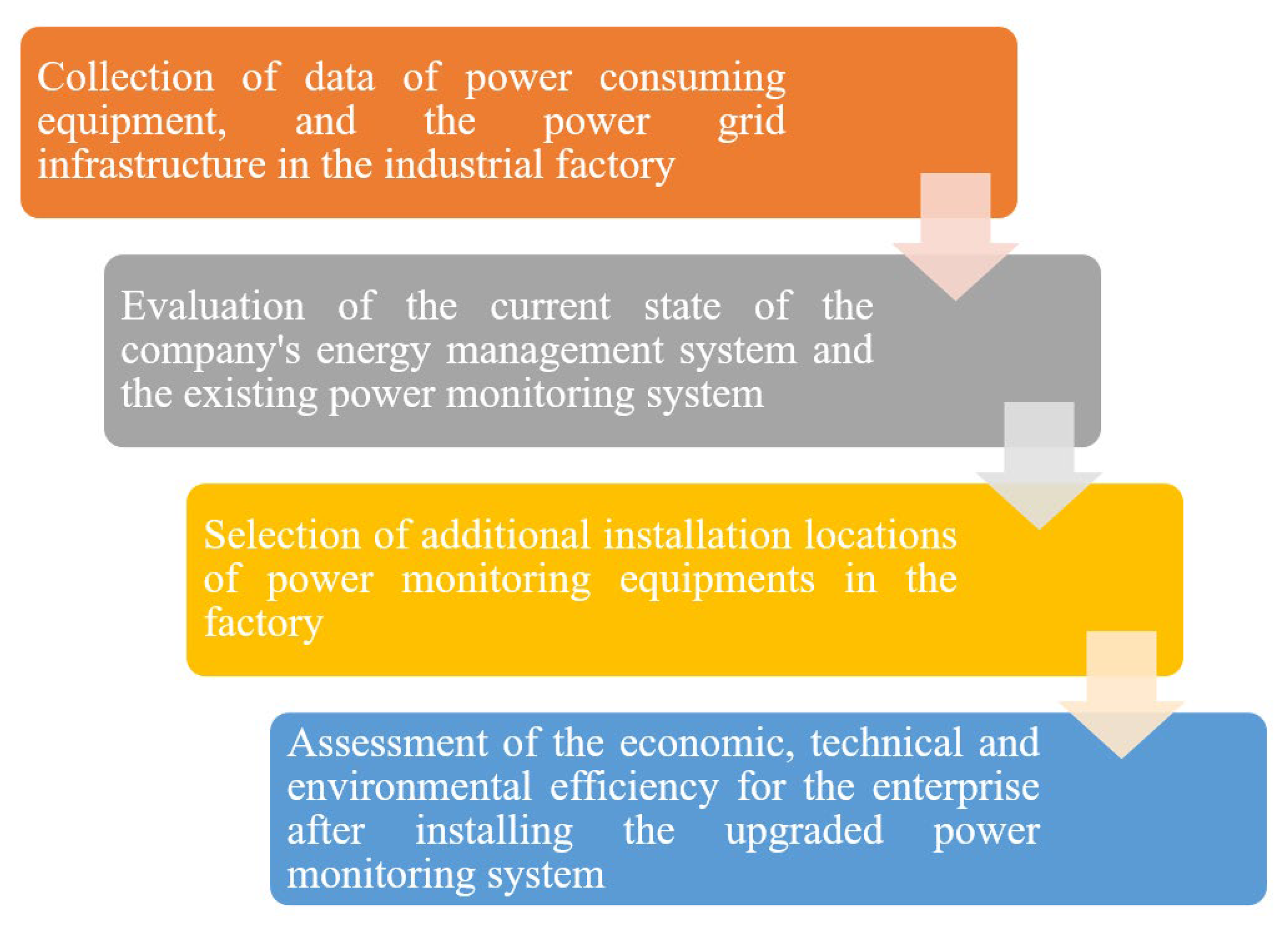
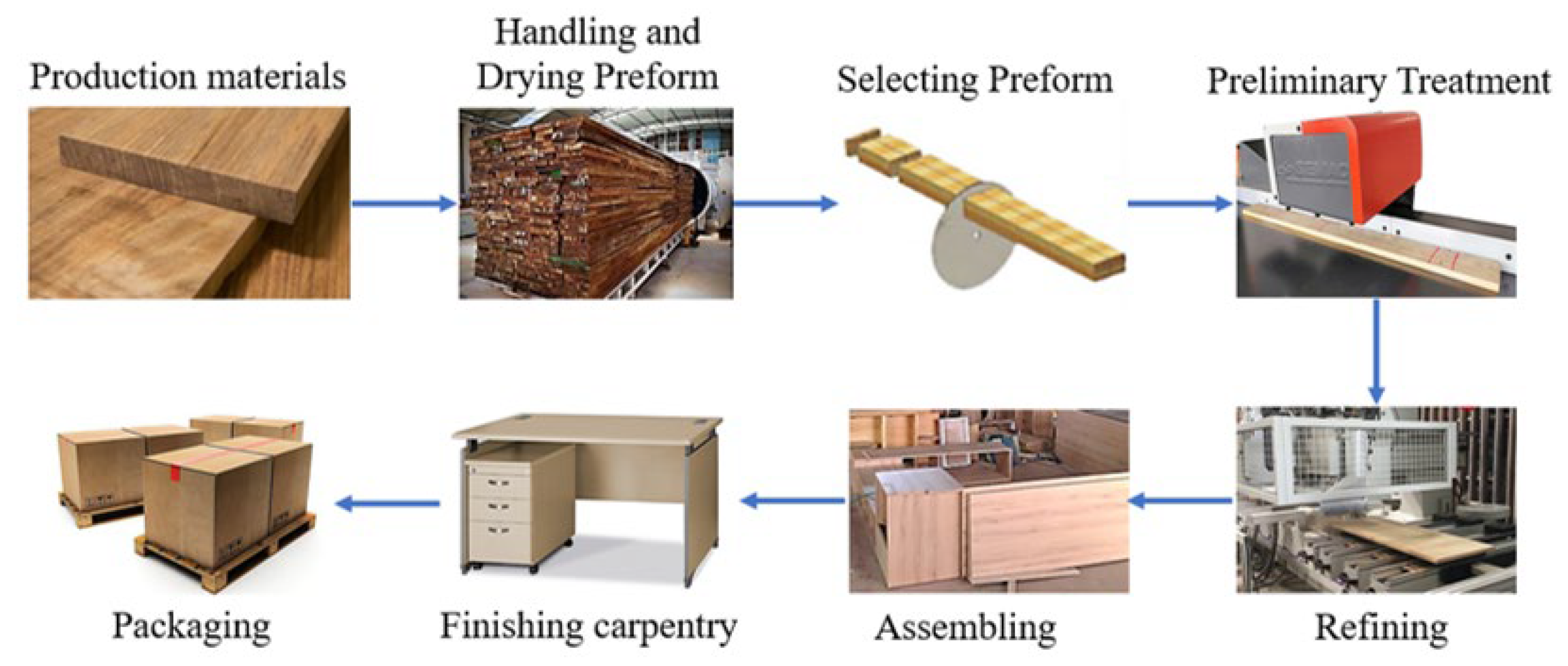
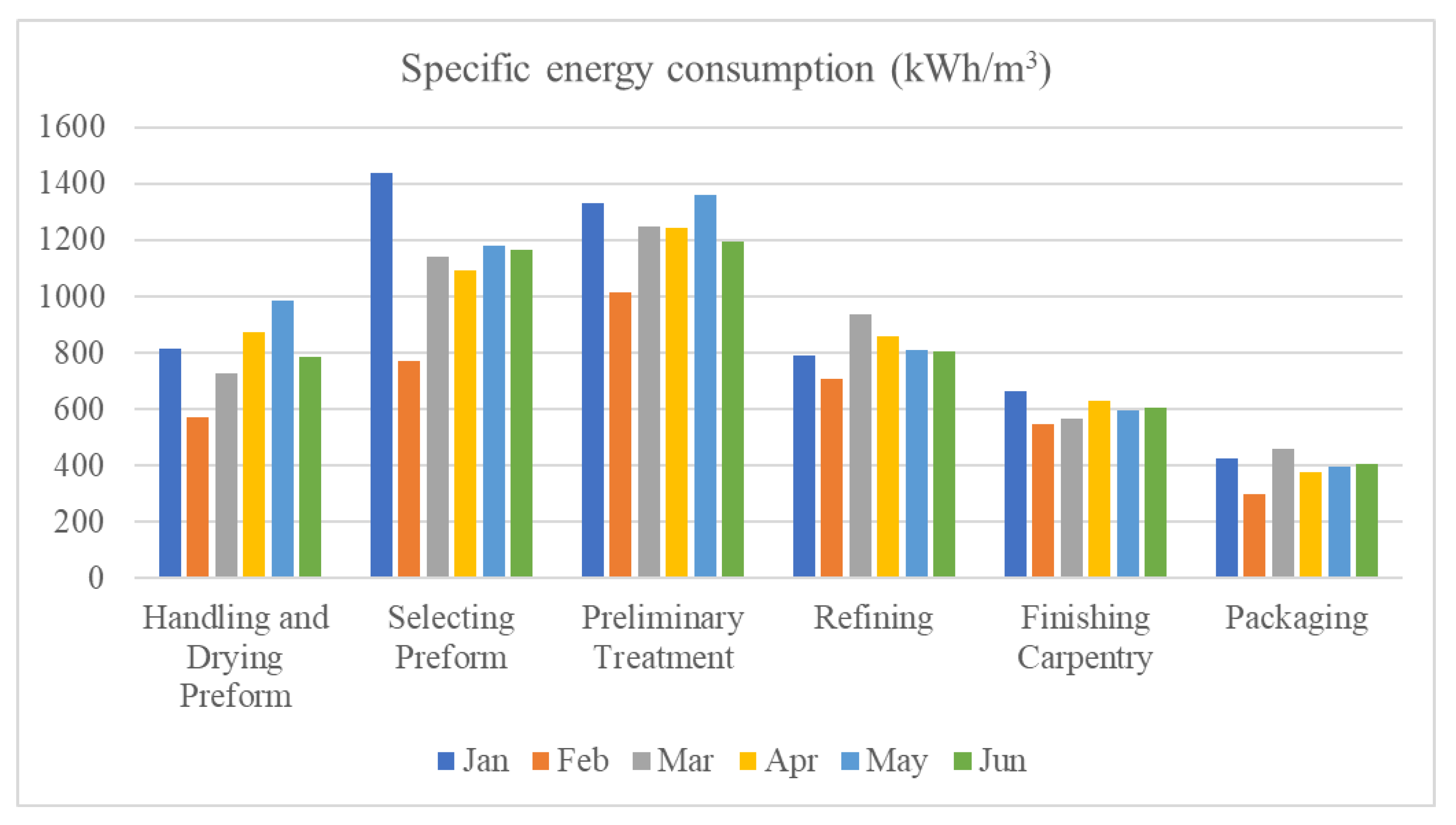
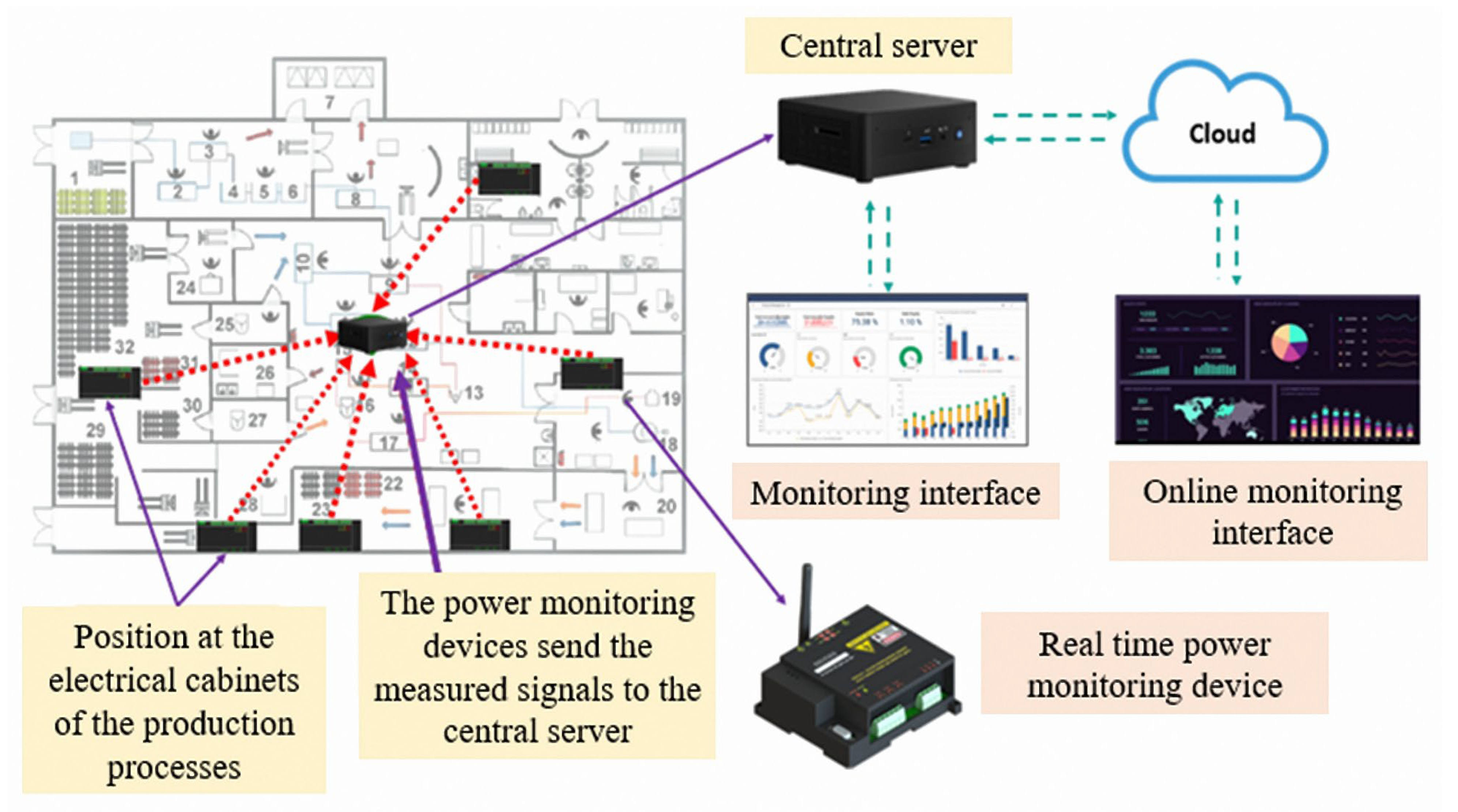
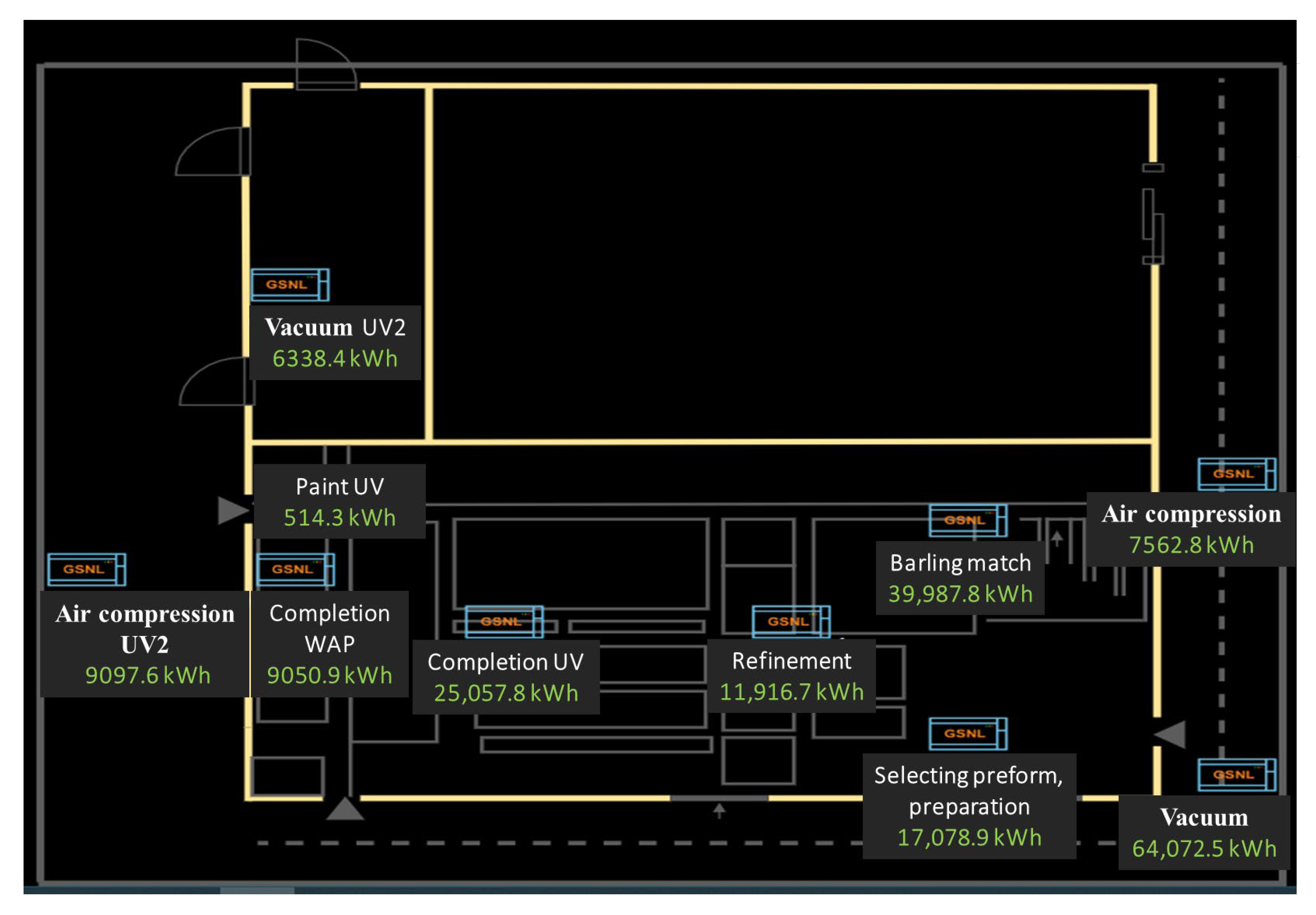
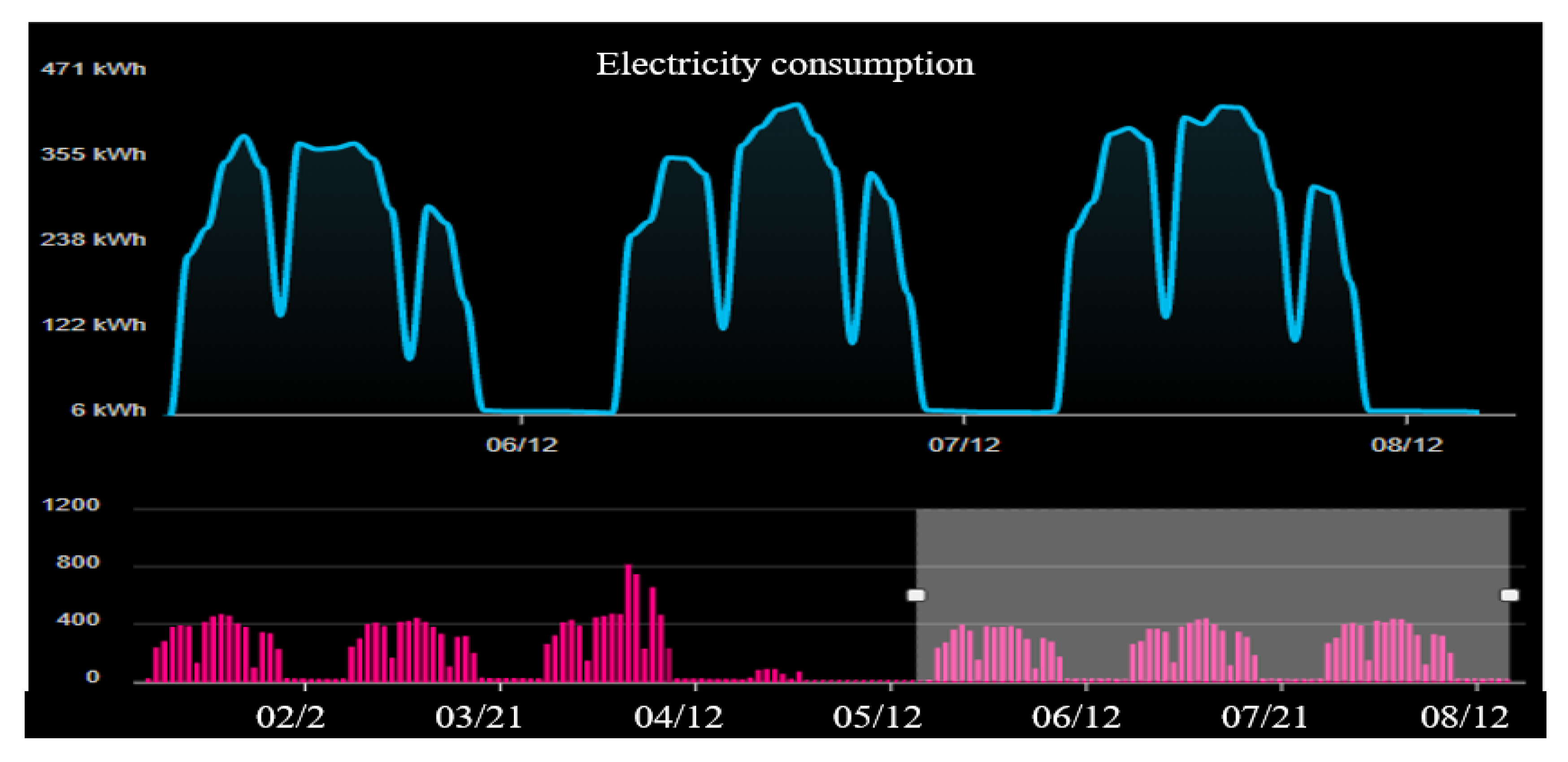

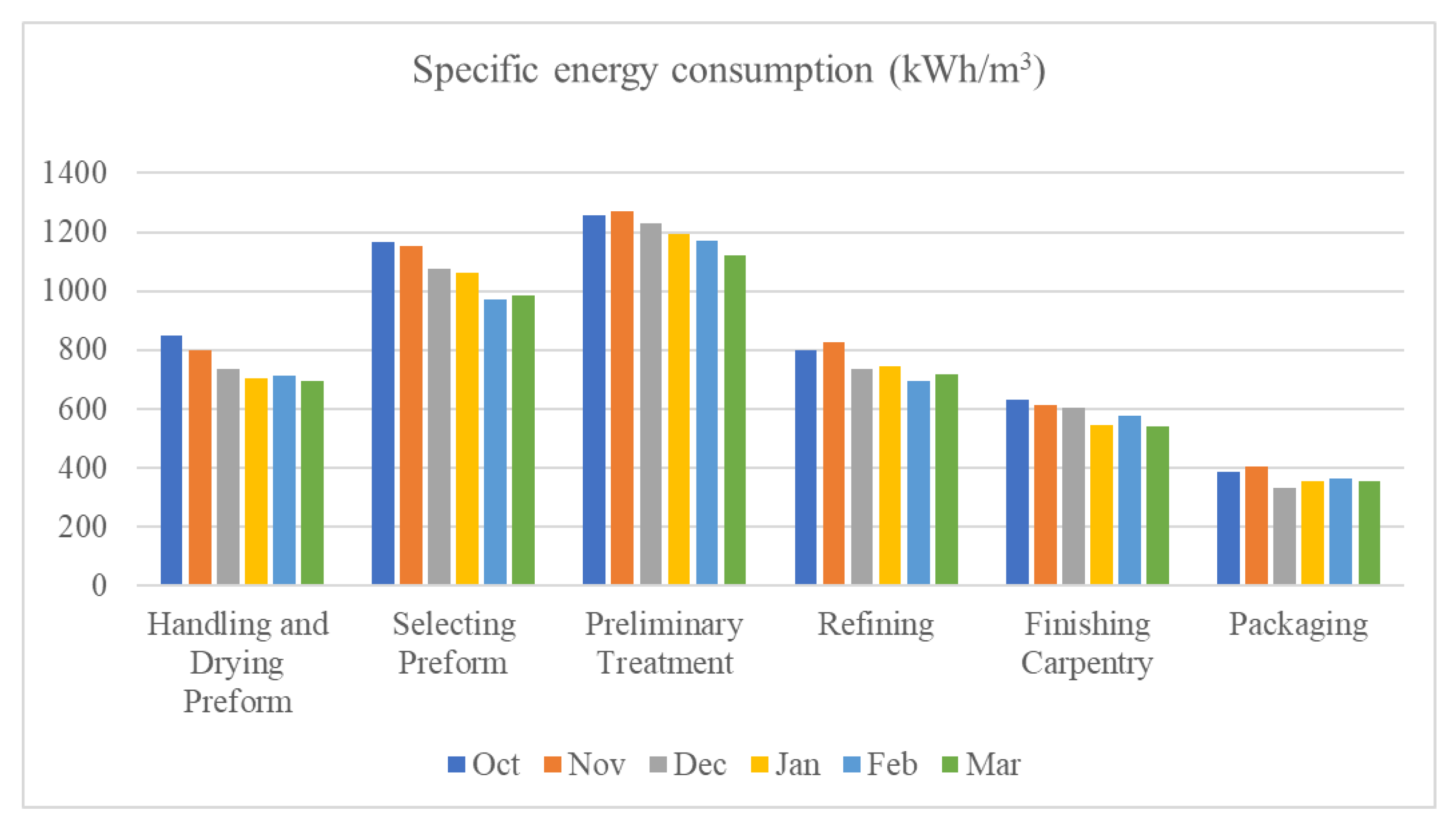
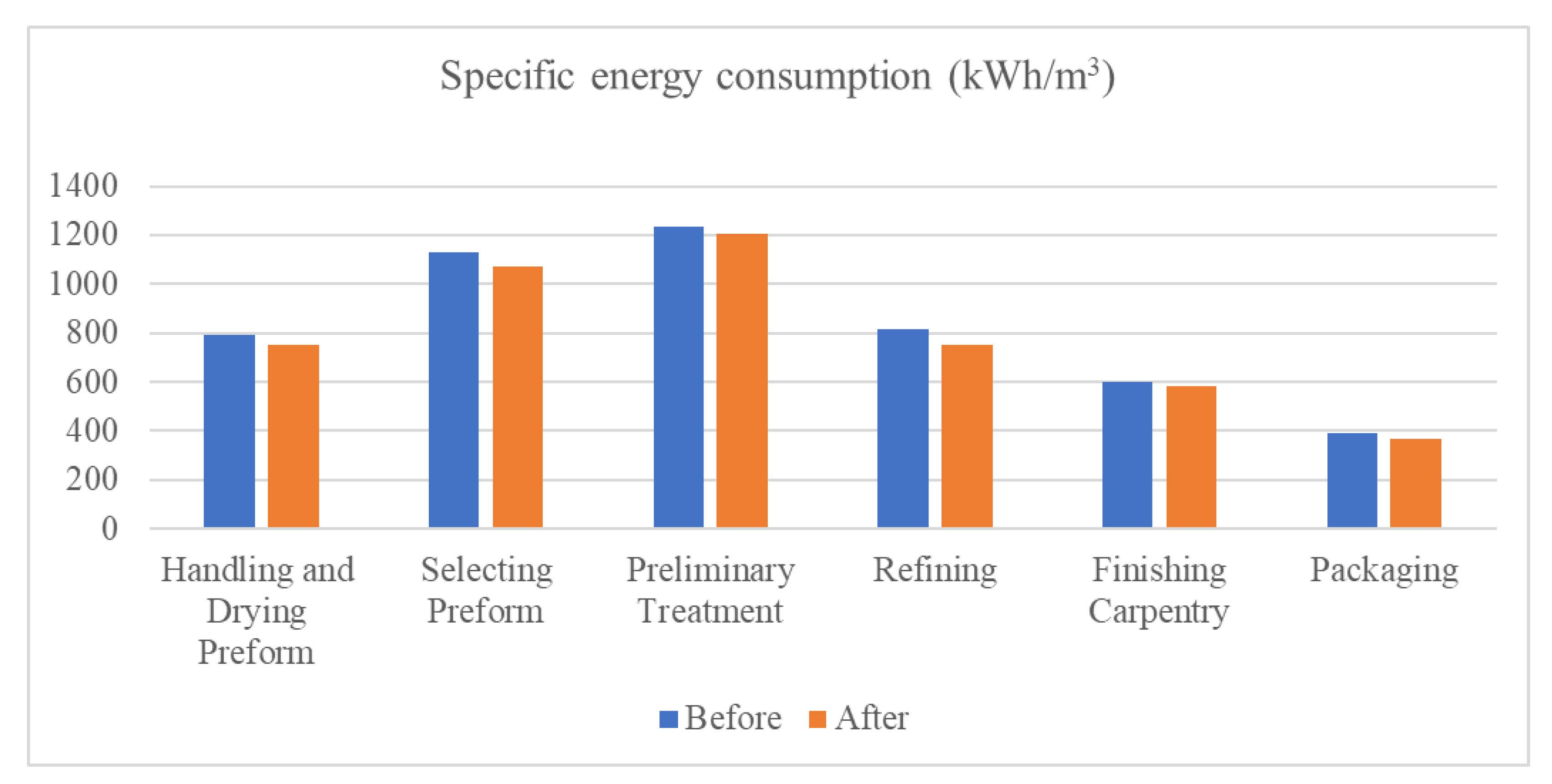
| No | Energy Type | Unit | Energy Consumption | Ton of Oil Equivalent (TOE) | Ratio (%) |
|---|---|---|---|---|---|
| 1 | Electricity | kWh | 6,924,180 | 1068 | 97.86 |
| 2 | Diesel oil | litre | 26,451 | 23.3 | 2.14 |
| Total | 1091.3 | 100 | |||
| Handling and Drying Preform | Selecting Preform | Preliminary Treatment | |||||||
| Outputvolume (m3) | Energy Consumption (kWh) | SEC (kWh/m3) | Outputvolume (m3) | Energy Consumption (kWh) | SEC (kWh/m3) | Outputvolume (m3) | Energy Consumption (kWh) | SEC (kWh/m3) | |
| January | 72 | 58,488 | 812 | 61 | 87,714 | 1438 | 101 | 134,495 | 1332 |
| February | 61 | 34,689 | 569 | 85 | 65,549 | 771 | 105 | 106,508 | 1014 |
| March | 99 | 72,184 | 729 | 95 | 108,291 | 1140 | 133 | 166,046 | 1248 |
| April | 84 | 73,548 | 876 | 101 | 110,322 | 1092 | 136 | 169,160 | 1244 |
| May | 72 | 70,926 | 985 | 90 | 106,389 | 1182 | 120 | 163,130 | 1359 |
| June | 96 | 75,330 | 785 | 97 | 112,995 | 1165 | 145 | 173,259 | 1195 |
| Refining | Finishing Carpentry | Packaging | |||||||
| Outputvolume (m3) | Energy consumption (kWh) | SEC (kWh/m3) | Outputvolume (m3) | Energy consumption (kWh) | SEC (kWh/m3) | Outputvolume (m3) | Energy consumption (kWh) | SEC (kWh/m3) | |
| January | 155 | 122,800 | 792 | 176 | 116,952 | 665 | 151 | 64,324 | 426 |
| February | 147 | 103,768 | 706 | 196 | 107,398 | 548 | 168 | 50,069 | 298 |
| March | 162 | 151,608 | 936 | 254 | 144,388 | 568 | 173 | 79,414 | 459 |
| April | 180 | 154,451 | 858 | 233 | 147,096 | 631 | 216 | 80,903 | 375 |
| May | 184 | 148,945 | 809 | 239 | 141,852 | 594 | 198 | 78,019 | 394 |
| June | 196 | 158,193 | 807 | 250 | 150,660 | 603 | 205 | 82,863 | 404 |
| No | Technical Parameter |
|---|---|
| 1 | Operating voltage: 100~260 (V) |
| 2 | Frequency: 50–60 (Hz) |
| 3 | Operating temperature: −20~60 °C |
| 4 | Operating Humidity: 5~95% |
| 5 | Power consumption: 5 (W) |
| 6 | Voltage measuring range: 220/380 (V) |
| 7 | Current measurement range: 0~1000 (A) |
| 8 | Power measurement range: 0~220 (kVA) |
| 9 | Error: 2 (%) |
| Handling and Drying Preform | Selecting Preform | Preliminary Treatment | Refining | Finishing Carpentry | Packaging | Total | |
|---|---|---|---|---|---|---|---|
| Volafter (m3) | 662 | 538 | 633 | 922 | 1.221 | 1.074 | 5.050 |
| Real electricity consumption (kWh) | 497.603 | 576.366 | 762.801 | 686.424 | 712.368 | 395.801 | 3631.363 |
| SECBefore (kWh/m3) | 793 | 1131 | 1232 | 818 | 601 | 392 | |
| Electricity consumption based on SECbefore (kWh) | 524.955 | 608.648 | 779.608 | 754.359 | 734.081 | 421.636 | 3823.287 |
| Saved electricity (kWh) | 27,351 | 32,282 | 16,807 | 69,935 | 21,714 | 25,834 | 191,923 |
| Total Saved Electricity (kWh) | 191,923 |
|---|---|
| Cost of saving electricity (VND) | 479,808,178 |
| Annual saving energy cost ratio (%) | 9.62 |
| Payback time (month) | 14 |
| The average reduction of CO2 (tons) | 139 |
Disclaimer/Publisher’s Note: The statements, opinions and data contained in all publications are solely those of the individual author(s) and contributor(s) and not of MDPI and/or the editor(s). MDPI and/or the editor(s) disclaim responsibility for any injury to people or property resulting from any ideas, methods, instructions or products referred to in the content. |
© 2023 by the authors. Licensee MDPI, Basel, Switzerland. This article is an open access article distributed under the terms and conditions of the Creative Commons Attribution (CC BY) license (https://creativecommons.org/licenses/by/4.0/).
Share and Cite
Dat, M.N.; Trung, K.D.; Minh, P.V.; Van, C.D.; Tran, Q.T.; Ngoc, T.N. Assessment of Energy Efficiency Using an Energy Monitoring System: A Case Study of a Major Energy-Consuming Enterprise in Vietnam. Energies 2023, 16, 5214. https://doi.org/10.3390/en16135214
Dat MN, Trung KD, Minh PV, Van CD, Tran QT, Ngoc TN. Assessment of Energy Efficiency Using an Energy Monitoring System: A Case Study of a Major Energy-Consuming Enterprise in Vietnam. Energies. 2023; 16(13):5214. https://doi.org/10.3390/en16135214
Chicago/Turabian StyleDat, Minh Nguyen, Kien Duong Trung, Phap Vu Minh, Chau Dinh Van, Quynh T. Tran, and Trung Nguyen Ngoc. 2023. "Assessment of Energy Efficiency Using an Energy Monitoring System: A Case Study of a Major Energy-Consuming Enterprise in Vietnam" Energies 16, no. 13: 5214. https://doi.org/10.3390/en16135214
APA StyleDat, M. N., Trung, K. D., Minh, P. V., Van, C. D., Tran, Q. T., & Ngoc, T. N. (2023). Assessment of Energy Efficiency Using an Energy Monitoring System: A Case Study of a Major Energy-Consuming Enterprise in Vietnam. Energies, 16(13), 5214. https://doi.org/10.3390/en16135214







